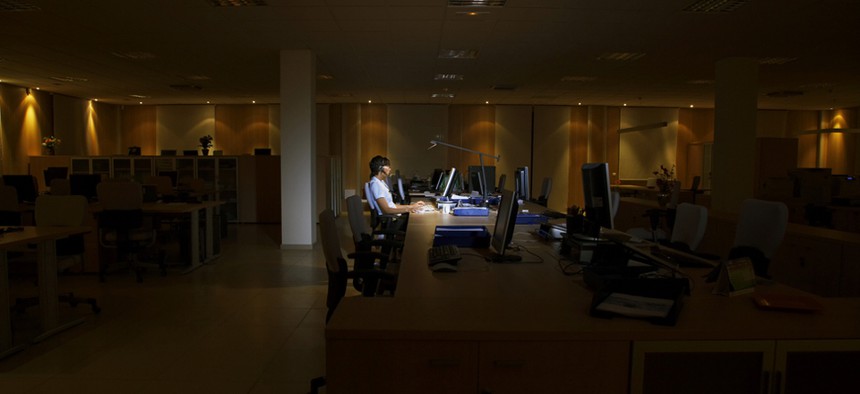The Murky Boundaries of the Modern Work Day
Americans don't seem to mind long hours that blur the lines between professional and personal life, but they do mind the inability to control their schedules.
When I ask David Cook, a pastor from North Carolina, how often his work life seeps into his personal life he laughs a bit as he answers, “All the time.” That seems to be a pretty common response when you ask people about the boundaries, or lack thereof, between work and home. In fact, most people I spoke with for this story let out a resigned chuckle when it came time to assess where exactly the distinction between work time and personal time was, if there was one at all.
“It’s very hard to know when I’m working and when I’m not,” says Cook. The fact that he sometimes works from home might be part of the issue, but the very nature of his work can make it difficult to decide what’s work and what’s not, since many of the people that he socializes with are also a part of his congregation, he says.
But people with inherently social jobs, like Cook, aren’t the only ones who find the boundaries between work and home difficult to navigate. For some, the inability to determine their schedule means that the workday often lasts well past family dinner time, and taking work home in the evenings or over weekends becomes part of the norm.
The most recent Allstate/National Journal Heartland Monitor Poll asked 1,000 Americans to think about how much they work and how they work in order to get an idea of when, and if, work life stops.
Of respondents who are currently working full-time jobs, one-third said that they work between 31 and 40 hours per week. About a quarter of those who are currently employed in full-time gigs listed their weekly hours as 51 or more. Respondents with these extended work hours were a fairly even split between senior-level employees and general staff.
Of those who worked more than 51 hours per week, men ages 18 to 49 outnumbered women in the same age group by a factor of more than three, and minority men seem to work 51 hours or more at a higher rate than their white counterparts.
Around 62 percent of Americans said that the number of hours they work is the right fit while 28 percent said that ideally, they’d scale back. Part-time workers were somewhat more content with their work hours, with 70 percent of respondents saying that they worked the right amount and 26 percent saying they wish they could put in more hours on the job. Of full-time employees about 60 percent said that their hours were spot-on, while more than one-third said that they would like to work less.
What exactly do Americans consider the correct amount of hours? More than three-in-four respondents who said they work between 31 and 40 hours thought they worked about the right amount. They are joined by 70 percent of those who work a nine-to-five schedule.
When it came to balancing work and home life, the main complaint seems to be less about overall hours and more about working an unpredictable schedule. Robert McCuen, whose job involves being available for troubleshooting for manufacturers, says that the inability to predict his schedule is what makes his work-life balance so tough. “Going in I have no idea how long the day is going to be,” McCuen says.
Americans feel varying levels of obligation about making themselves available outside of work.About 41 percent of those who are currently employed say that their job frequently requires them to be in contact outside of the office. And of those who do check in after working hours, about 56 percent said that they checked in even while on vacation.
Touching base while on vacation isn’t that big of an issue for 41-year-old River Medina, a transportation manager in Texas, but that’s because she can’t remember the last time she took one. When I ask her about the days that she takes off from work, she has to think for a while and then realizes that she hasn’t really taken much time off at all. “The only times I’ve taken off were funerals. I work from home on sick days,” Medina says.
And not using paid vacation, and sometimes even sick days, is a fairly common practice. Among all full-time employees only about 36 percent said that they used all, or almost all, of their paid sick or vacation days. Among part-time workers the frequency was less than half that rate.
Medina wouldn’t necessarily consider herself a willful workaholic. “The job keeps me so busy during the day that I use my off time to catch up on stuff. It’s exhausting.” she says. “Most of the time it’s like, I know we’re still working on this or that, I never feel like I’m safe to take time off.”
Both Medina and McCuen agree; more flexibility to take time off would be helpful. Medina suggests mandatory vacation to prevent worker burnout. McCuen’s views are more centered on the constant balancing act between family and career that he says gets skewed, since work flexibility tends to come with seniority. At 48, and with his children mostly grown, McCuen says that he has less of a need for family-friendly hours than he once did. “I’ve always thought we had it kind of backwards,” he says. “When people are starting out with a young family they need lots of vacation and free time. When I was younger that’s when I really needed the time.”
(Image via bikeriderlondon/Shutterstock.com)



